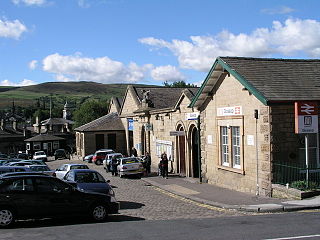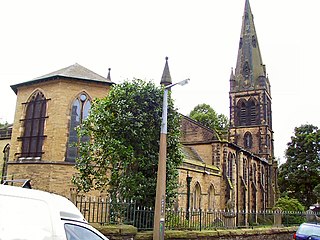
Gloucester Cathedral, formally the Cathedral Church of St Peter and the Holy and Indivisible Trinity, in Gloucester, England, stands in the north of the city near the River Severn. It originated with the establishment of a minster, Gloucester Abbey, dedicated to Saint Peter and founded by Osric, King of the Hwicce, in around 679. The subsequent history of the church is complex; Osric's foundation came under the control of the Benedictine Order at the beginning of the 11th century and in around 1058, Ealdred, Bishop of Worcester, established a new abbey "a little further from the place where it had stood". The abbey appears not to have been an initial success, by 1072, the number of attendant monks had reduced to two. The present building was begun by Abbott Serlo in about 1089, following a major fire the previous year.

The Willesden United Synagogue Cemetery, usually known as Willesden Jewish Cemetery, is a Jewish cemetery at Beaconsfield Road, Willesden, in the London Borough of Brent, England. It opened in 1873 on a 20-acre (0.08 km2) site. It has been described as the "Rolls-Royce" of London's Jewish cemeteries and is designated Grade II on Historic England's Register of Historic Parks and Gardens. The cemetery, which has 29,800 graves, has many significant memorials and monuments. Four of them are listed at Grade II. They include the tomb of Rosalind Franklin, who was a co-discoverer of the structure of DNA.

Little Hayfield is a hamlet in the Peak District National Park, in Derbyshire, England. It lies on the A624 between Hayfield and Glossop. At the centre of the hamlet is the Lantern Pike pub, named after the nearby hill of the same name. Fell racing take place in Little Hayfield, and until 2021 an annual country show was held on a local farm, including sheepdog trials.

Glossop railway station serves the Peak District town of Glossop in Derbyshire, England. Glossop is the third busiest railway station in the county of Derbyshire after Derby and Chesterfield. It is located just north of Norfolk Square in the centre of Glossop.

St. James's Church is an Anglican church in the evangelical tradition in the town of Glossop, Derbyshire, in the north-west of England. Along with St. Luke's Church, it makes up Whitfield Parish within Derby Diocese.

Chunal is a hamlet in Derbyshire, England. It is located on the A624 road, 1 mile south of Glossop. The philosopher Ludwig Wittgenstein conducted aeronautical research at Chunal during his time as an engineering research student at Manchester University (1908–1911). He flew kites into the upper atmosphere.

The Bromley War Memorial in Bromley, Greater London, England commemorates the fallen of World War I and World War II. It was designed by British sculptor Sydney March, of the March family of artists.
Laurence Arthur Turner FSA was an English artisan and master craftsman.
There are 137 Grade II* listed war memorials in England, out of over 4,000 listed war memorials. In the United Kingdom, a listed building is a building or structure of special historical or architectural importance; listing offers the building legal protection against demolition or modification, which requires permission from the local planning authority. Listed buildings are divided into three categories—Grade I, Grade II*, and Grade II—which reflect the relative significance of the structure and may be a factor in planning decisions. Grade I is the most significant and accounts for 2.5% of listed buildings, while Grade II accounts for 92%. Grade II* is the intermediate grade accounting for the remaining 5.5%; it is reserved for "particularly important buildings of more than special interest".

Croydon Cenotaph is a war memorial, in Croydon, London, England. It is located outside the Croydon Clocktower arts complex, on Katharine Street in Croydon.
Hazel Grove and Bramhall are towns in the Metropolitan Borough of Stockport, Greater Manchester, England. The towns, together with the village of Woodford, contain 29 listed buildings that are recorded in the National Heritage List for England. Of these, one is listed at Grade I, the highest of the three grades, one is at Grade II*, the middle grade, and the others are at Grade II, the lowest grade. Most of the listed buildings are houses and associated structures, farmhouses and farm buildings. The other listed buildings include churches and lych gates, and two war memorials.

The Dulwich Old College War Memorial is located in the forecourt of Dulwich Old College on College Road in Dulwich in the London Borough of Southwark. It marks the deaths of the former pupils of the college who died in the First World War between 1914 and 1919. The memorial is made from Hopton Wood stone and was designed by William Douglas Caröe. It was unveiled in 1921. It has been grade II listed on the National Heritage List for England since May 2010. The heritage listing places the memorial within a "visual and contextual relationship" with the Grade II listed Old College building and the entrance gates and piers of the Old College, also Grade II listed.

Glossop Gas Works is a historic building in Glossop, England. It was constructed in the late 19th century on Arundel Street, Glossop, as the headquarters of the town's gas company.
Glossop is a market town in the High Peak district of Derbyshire, England. The town and surrounding areas, which include Dinting and Old Glossop, contain 56 listed buildings that are recorded in the National Heritage List for England. All the listed buildings are designated at Grade II, the lowest of the three grades, which is applied to "buildings of national importance and special interest". The town originated in what is now Old Glossop, where the older buildings are to be found, and in the 19th century its centre moved to the southwest, into the area known as New Glossop, or Howard Town centred around Norfolk Square. Most of the listed buildings are houses, cottages and farmhouses and associated structures, and the others include churches and items in churchyards, chapels, some of which have been converted for other uses, shops, public houses, public buildings, a market cross, a drinking trough, a former cotton mill, a railway station, a school, a bank, a theatre, a war memorial, and a pair of telephone kiosks.

Norfolk Square is in the centre of Glossop in Derbyshire, England, a former mill town close to the outskirts of Greater Manchester to the west and the Peak District to the east. It forms part of the town centre, adjacent to the crossroads where the A57 road meets the A624. Glossop railway station, opened in 1845, is just to the north of the square. It is at the centre of modern Glossop, with many of the buildings dating from the 19th century, as the heart of the town shifted westwards from Old Glossop during the Industrial Revolution. It forms the focus of the town's commercial area with numerous shops, restaurants and pubs in the streets leading off it.












